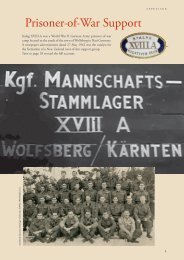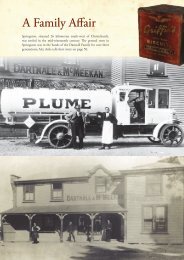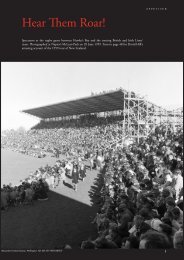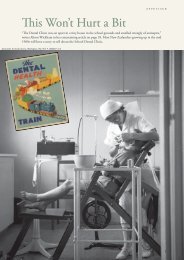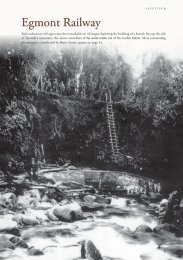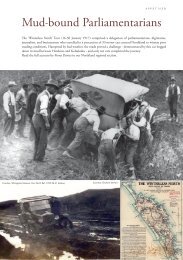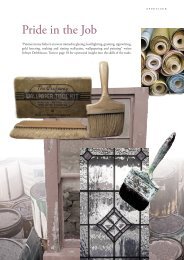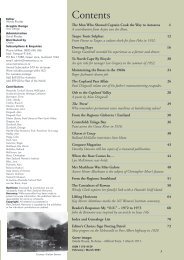New Zealand Memories Issue 155
Issue 156 Contents Kriegsmarine U-boat 862 Secret incursion into Gisborne and Napier Harbours: Gerald Shone’s research. 4 Nature Knows Best 11 A horticultural tale from Keith Davis. Building the Midland Line Across the Southern Alps 12 David Relph tracks progress of the 1870 rail proposal. The Magic Robot 17 A childhood toy never forgotten by Irene Beagle. From the Regions: Waikato 18 Knucklebones in ’53 30 Christopher Moor reminds readers of the popular game. Quinces to Queen Victoria An unlikely story … or is it? A contribution from Kelvin Smith. Centrefold: Suitably Hatted 36 Richard John Seddon on tour in the South Island, 1906. Flying Skies and Killing Flies 38 Insecticide spraying on aircraft: an article by Pat Dale. Farm Machinery Back in the Thirties 44 On the farm with Mags Meechang. Cinemas of Old: Tuatapere and Geraldine 47 Picture theatre nostalgia with John McKinnon First Impressions of New Zealand 48 Bert Toomey arrived aboard the M.V. Cumberland in 1953. From the Regions: Whanganui / Manawatu 50 The Queen Street Greyhound 61 Mike Subritzky in his ancestor’s motorcar. The F.G.R. Trademark 62 Profile: scenic photographer Frederick George Radcliffe. Reader’s Response: Government Recruited Teaching Staff 67 Mailbox 68 Index and Genealogy List 70 Editor’s Choice: Tasman Glacier 72 Photographed on 9 March 1957 by Robert Reynolds.
Issue 156 Contents
Kriegsmarine U-boat 862
Secret incursion into Gisborne and Napier Harbours: Gerald Shone’s research. 4
Nature Knows Best 11
A horticultural tale from Keith Davis.
Building the Midland Line Across the Southern Alps 12
David Relph tracks progress of the 1870 rail proposal.
The Magic Robot 17
A childhood toy never forgotten by Irene Beagle.
From the Regions: Waikato 18
Knucklebones in ’53 30
Christopher Moor reminds readers of the popular game.
Quinces to Queen Victoria
An unlikely story … or is it? A contribution from Kelvin Smith.
Centrefold: Suitably Hatted 36
Richard John Seddon on tour in the South Island, 1906.
Flying Skies and Killing Flies 38
Insecticide spraying on aircraft: an article by Pat Dale.
Farm Machinery Back in the Thirties 44
On the farm with Mags Meechang.
Cinemas of Old: Tuatapere and Geraldine 47
Picture theatre nostalgia with John McKinnon
First Impressions of New Zealand 48
Bert Toomey arrived aboard the M.V. Cumberland in 1953.
From the Regions: Whanganui / Manawatu 50
The Queen Street Greyhound 61
Mike Subritzky in his ancestor’s motorcar.
The F.G.R. Trademark 62
Profile: scenic photographer Frederick George Radcliffe.
Reader’s Response: Government Recruited Teaching Staff 67
Mailbox 68
Index and Genealogy List 70
Editor’s Choice: Tasman Glacier 72
Photographed on 9 March 1957 by Robert Reynolds.
You also want an ePaper? Increase the reach of your titles
YUMPU automatically turns print PDFs into web optimized ePapers that Google loves.
APPETISER<br />
Aircraft Fumigation<br />
Who recalls the routine insecticide spraying of aeroplane cabins at <strong>New</strong> <strong>Zealand</strong> airports before alighting from<br />
international flights? This was administered by either cabin crew or by quarantine officers. Pat Dale’s humorous<br />
article Flying Skies and Killing Flies on page 38 reveals all.<br />
Ministry for Primary Industries ‘Aircraft disinsection’, URL: https://nzhistory.govt.nz/media/photo/aircraft-disinsection, (Ministry for Culture and Heritage), updated 11-Jul-2019<br />
1
EDITORIAL<br />
Dear Readers,<br />
World War II wartime secrets, kept under wraps for decades, have filtered out to<br />
the general public over latter years. In 1992, journalists printed the shocking secret<br />
of the presence of a U-boat in <strong>New</strong> <strong>Zealand</strong> waters in January 1945. Gerald Shone<br />
diligently traced the route and exploits of U-boat 862 to the point of meeting<br />
several of its German crew some 50 years after the war in order to further his<br />
research and book. Gerald’s siblings have contributed this intriguing account on<br />
Gerald’s behalf.<br />
Remember the instruction “Remain seated” when returning from international<br />
destinations while the airline cabin underwent spraying? DSIR officer Pat Dale<br />
was part of the mechanism engaged to eliminate foreign insects from entering <strong>New</strong> <strong>Zealand</strong> soil. Was the<br />
initiative effective? Pat Dale relates the amusing story.<br />
Knucklebones is the topic of Christopher Moor’s nostalgic contribution. The story is certainly a reminder of<br />
my schooldays when I spent hours throwing the five silver knucklebones into the air to play out ‘overhands’,<br />
‘scatters’, ‘dumps’ and the more difficult ‘catching flies’ while competing with friends. I’m inspired to try my<br />
hand at the game again and test my dexterity.<br />
David Relph, who provided an excellent historic account of the first road across the Southern Alps in <strong>Issue</strong><br />
146, returns with the building of the railway across the same divide. First proposed in 1870, the railway had to<br />
surmount obstacles such as the Waimakariri Gorge with little machinery and in grueling conditions. Fortitude<br />
and determination are words that spring to mind.<br />
The inclusion of a selection of shorter pieces brings diversity. Farm machinery in Southland, quinces delivered<br />
to Queen Victoria from Auckland, the astonishing discovery of a much-loved ancestral Oldsmobile and, in the<br />
Waikato section, digging for moa bones at Upokongaro. Always something unique to add to the mix.<br />
Reports of family reunions taking place, with loved ones reunited, have been a joy to hear. Let us hope for more<br />
normality as the year progresses.<br />
Warm regards,<br />
Wendy Rhodes,<br />
Editor<br />
For just $68 you receive an annual<br />
subscription to <strong>New</strong> <strong>Zealand</strong> <strong>Memories</strong>.<br />
Five superb issues direct to your letterbox.<br />
A G i f t o f D i s t i n c t i o n<br />
Surprise a friend or relative with a gift subscription.<br />
We will even gift wrap the first issue, include a gift<br />
card with your personal message and post it direct.<br />
Freephone: 0800 696 366 or<br />
Freepost: 91641<br />
PO Box 17288<br />
Green Lane, Auckland 1546<br />
Email: admin@memories.co.nz<br />
Subscribe and Save!<br />
Visit our website w w w.memories.co.nz for subscriptions and gift ideas.<br />
Order online securely today and pay via internet banking or credit card.<br />
2
Editor<br />
Wendy Rhodes<br />
Graphic Design<br />
Icon Design<br />
Administration<br />
David Rhodes<br />
Distributed by<br />
Are Direct<br />
Subscriptions & Enquiries<br />
Phone tollfree: 0800 696 366<br />
Mail: Freepost 91641,<br />
PO Box 17288, Greenlane, Auckland 1546<br />
email: admin@memories.co.nz<br />
www.memories.co.nz<br />
Annual Subscription $68 for five issues<br />
(Price includes postage within NZ)<br />
Contributors<br />
Alexander Turnbull Library, Wellington, NZ<br />
Auckland City Libraries Heritage Collections<br />
Beagle, Irene<br />
Canterbury Museum<br />
Cummings Family<br />
Davis, Keith<br />
de Rouffignac, Ross<br />
Finlay Family<br />
Fitness, Alan<br />
Grafton, Margaret<br />
Hawke’s Bay Museum Trust,<br />
Ruawharo Ta-u-rangi<br />
Herdman, Vern<br />
History House, Greymouth<br />
Isted, Bruce<br />
Mathers Family<br />
McKinnon, John<br />
Meechang, Mags<br />
Meechang, Maurie<br />
Ministry for Culture and Heritage<br />
Ministry for Primary Industries<br />
Moor, Christopher<br />
Moore, Anne<br />
Norsewood Pioneer Museum<br />
Pickmere, Alan<br />
Presbyterian Research Centre<br />
Radcliffe, Graham<br />
Relph, David<br />
Reynolds, Robert<br />
Shone, Gerald<br />
Shone, Mike<br />
Shone, Sue<br />
Sinclair, George<br />
Sinclair, Roy<br />
Stewart, Graham<br />
Tarawhiti Museum<br />
Taupo Museum and Art Gallery<br />
Walsh, Michael<br />
West, Valerie<br />
Opinions: Expressed by contributors are not<br />
necessarily those of <strong>New</strong> <strong>Zealand</strong> <strong>Memories</strong>.<br />
Accuracy: While every effort has been made to<br />
present accurate information, the publishers take no<br />
responsibility for errors or omissions.<br />
Copyright: All material as presented in<br />
<strong>New</strong> <strong>Zealand</strong> <strong>Memories</strong> is copyright to the publishers<br />
or the individual contributors as credited.<br />
ISSN 1173-4159<br />
June/July 2022<br />
Contents<br />
Kriegsmarine U-boat 862 4<br />
Secret incursion into Gisborne Harbour: Gerald Shone’s research.<br />
Nature Knows Best 11<br />
A horticultural tale from Keith Davis.<br />
Building the Midland Line Across the Southern Alps 12<br />
David Relph tracks progress of the 1870 rail proposal.<br />
The Magic Robot 17<br />
A childhood toy never forgotten by Irene Beagle.<br />
From the Regions: Waikato 18<br />
Man of Mysteries 28<br />
Fergus Hume is profiled by David Hill.<br />
Knucklebones in ’53 30<br />
Christopher Moor reminds readers of the popular game.<br />
Quinces to Queen Victoria 34<br />
An unlikely story … or is it? A contribution from Kelvin Smith.<br />
Centrefold: Suitably Hatted 36<br />
Richard John Seddon on tour in the South Island, 1906.<br />
Flying Skies and Killing Flies 38<br />
Insecticide spraying on aircraft: an article by Pat Dale.<br />
Farm Machinery Back in the Thirties 44<br />
On the farm with Mags Meechang.<br />
Cinemas of Old: Tuatapere and Geraldine 47<br />
Picture theatre nostalgia with John McKinnon.<br />
First Impressions of <strong>New</strong> <strong>Zealand</strong> 48<br />
Bert Toomey arrived aboard the M.V. Cumberland in 1953.<br />
From the Regions: Whanganui / Manawatu 50<br />
The Queen Street Greyhound 61<br />
Mike Subritzky in his ancestor’s motorcar.<br />
The F.G.R. Trademark 62<br />
Profile: scenic photographer Frederick George Radcliffe.<br />
Reader’s Response: Government Recruited Teaching Staff 67<br />
Mailbox 68<br />
Index and Genealogy List 70<br />
Editor’s Choice: Tasman Glacier 72<br />
Photographed on 9 March 1957 by Robert Reynolds.<br />
Cover image:<br />
Whanganui River settlement,<br />
24 March 1906. (Article page 62)<br />
Courtesy: A. Pickmere<br />
3
Editor<br />
Wendy Rhodes<br />
Graphic Design<br />
Icon Design<br />
Administration<br />
David Rhodes<br />
Distributed by<br />
Are Direct<br />
Subscriptions & Enquiries<br />
Phone tollfree: 0800 696 366<br />
Mail: Freepost 91641,<br />
PO Box 17288, Greenlane, Auckland 1546<br />
email: admin@memories.co.nz<br />
www.memories.co.nz<br />
Annual Subscription $68 for five issues<br />
(Price includes postage within NZ)<br />
Contributors<br />
Alexander Turnbull Library, Wellington, NZ<br />
Auckland City Libraries Heritage Collections<br />
Beagle, Irene<br />
Canterbury Museum<br />
Cummings Family<br />
Davis, Keith<br />
de Rouffignac, Ross<br />
Finlay Family<br />
Fitness, Alan<br />
Grafton, Margaret<br />
Hawke’s Bay Museum Trust,<br />
Ruawharo Ta-u-rangi<br />
Herdman, Vern<br />
History House, Greymouth<br />
Isted, Bruce<br />
Mathers Family<br />
McKinnon, John<br />
Meechang, Mags<br />
Meechang, Maurie<br />
Ministry for Culture and Heritage<br />
Ministry for Primary Industries<br />
Moor, Christopher<br />
Moore, Anne<br />
Norsewood Pioneer Museum<br />
Pickmere, Alan<br />
Presbyterian Research Centre<br />
Radcliffe, Graham<br />
Relph, David<br />
Reynolds, Robert<br />
Shone, Gerald<br />
Shone, Mike<br />
Shone, Sue<br />
Sinclair, George<br />
Sinclair, Roy<br />
Stewart, Graham<br />
Tarawhiti Museum<br />
Taupo Museum and Art Gallery<br />
Walsh, Michael<br />
West, Valerie<br />
Opinions: Expressed by contributors are not<br />
necessarily those of <strong>New</strong> <strong>Zealand</strong> <strong>Memories</strong>.<br />
Accuracy: While every effort has been made to<br />
present accurate information, the publishers take no<br />
responsibility for errors or omissions.<br />
Copyright: All material as presented in<br />
<strong>New</strong> <strong>Zealand</strong> <strong>Memories</strong> is copyright to the publishers<br />
or the individual contributors as credited.<br />
ISSN 1173-4159<br />
June/July 2022<br />
Contents<br />
Kriegsmarine U-boat 862 4<br />
Secret incursion into Gisborne Harbour: Gerald Shone’s research.<br />
Nature Knows Best 11<br />
A horticultural tale from Keith Davis.<br />
Building the Midland Line Across the Southern Alps 12<br />
David Relph tracks progress of the 1870 rail proposal.<br />
The Magic Robot 17<br />
A childhood toy never forgotten by Irene Beagle.<br />
From the Regions: Waikato 18<br />
Man of Mysteries 28<br />
Fergus Hume is profiled by David Hill.<br />
Knucklebones in ’53 30<br />
Christopher Moor reminds readers of the popular game.<br />
Quinces to Queen Victoria 34<br />
An unlikely story … or is it? A contribution from Kelvin Smith.<br />
Centrefold: Suitably Hatted 36<br />
Richard John Seddon on tour in the South Island, 1906.<br />
Flying Skies and Killing Flies 38<br />
Insecticide spraying on aircraft: an article by Pat Dale.<br />
Farm Machinery Back in the Thirties 44<br />
On the farm with Mags Meechang.<br />
Cinemas of Old: Tuatapere and Geraldine 47<br />
Picture theatre nostalgia with John McKinnon.<br />
First Impressions of <strong>New</strong> <strong>Zealand</strong> 48<br />
Bert Toomey arrived aboard the M.V. Cumberland in 1953.<br />
From the Regions: Whanganui / Manawatu 50<br />
The Queen Street Greyhound 61<br />
Mike Subritzky in his ancestor’s motorcar.<br />
The F.G.R. Trademark 62<br />
Profile: scenic photographer Frederick George Radcliffe.<br />
Reader’s Response: Government Recruited Teaching Staff 67<br />
Mailbox 68<br />
Index and Genealogy List 70<br />
Editor’s Choice: Tasman Glacier 72<br />
Photographed on 9 March 1957 by Robert Reynolds.<br />
Cover image:<br />
Whanganui River settlement,<br />
24 March 1906. (Article page 62)<br />
Courtesy: A. Pickmere<br />
3
WORLD WAR II<br />
Kriegsmarine U-boat 862<br />
Secret incursion into Gisborne and Napier Harbours during World War II.<br />
Gerald Shone<br />
Prepared by Mike and Sue Shone; siblings of the late Gerald Shone.<br />
Tūranga-nui-a-Kiwa – the “Great standing place of Kiwa” – was asleep when a U-boat made a secret<br />
nocturnal visit in January 1945. Gisborne harbour has been host to many ocean-going wakas, sailing<br />
ships, naval vessels, home and fishing boats over several centuries – a river port and a safe harbour<br />
from the southerly swells of Poverty Bay.<br />
Gisborne boasts a large stretch of coastline with popular beaches and it is also sometimes referred to as the<br />
‘City of Rivers’ because it sits at the convergence of three rivers. At only 1200 metres long, Turanganui is the<br />
shortest river in <strong>New</strong> <strong>Zealand</strong>.<br />
During World War II Gisborne was a strategically important airbase and port, visited by numerous friendly<br />
naval and armed-merchantmen. Gisborne citizens played a significant role in the defence of <strong>New</strong> <strong>Zealand</strong> and<br />
in protecting the food supplies being exported to Britain from Poverty Bay.<br />
Active in all branches of the armed forces both at home and abroad were people from Gisborne and the<br />
Tairãwhiti region. Included was the famous Battle of the River Plate. 1 It was the heroism and courage of Ngati<br />
Porou in Company C of the 28th Mãori Battalion which marked the fierce and costly battle of Monte Cassino<br />
in Italy.<br />
1 Bert Millier, Doug Gregory, Duncan McColl and Joe Quinn - The lads in blue<br />
- by Wynsley Wrigley, Gisborne Herald - Published December 14, 2019 Gisborne Harbour 1943.<br />
Courtesy: Tairawhiti Museum<br />
4
WORLD WAR II<br />
Alexander Turnbull Library, Wellington NZ Ref PAColl-4161-01-040 Wilkinson collection.<br />
The five-inch gun at the Kaiti Hill battery, Gisborne c1943. The gun had<br />
been decommissioned a few weeks before U-862 arrived in Poverty Bay.<br />
But by the end of 1944, the war was as good as over in the minds of most Gisbornites and, following D-day<br />
in Europe, they felt that victory was close at hand, as was peace in the Pacific.<br />
For the nearest the war had approached Gisborne was the passage of the Japanese submarines I-21 and I-25 –<br />
and all some considerable distance out from Poverty Bay.<br />
Gisborne had even started to de-militarise; rolls of barbed wire had been removed from the beaches and the<br />
large 5-inch gun emplacement on Kaiti Hill had been dismounted. And the RNZAF squadrons of Vildebeestes,<br />
Harvards, Grumman Avengers and Lockheed Ventura bombers based at Darton Field Gisborne had all been<br />
demobilised.<br />
Thus, the Gisborne of January 1945 was practically defenceless. Yet on 15th January 1945, as the end of the<br />
war approached, Gisborne faced its first real threat. For a German “super-sub” lay carefully submerged offshore<br />
observing, planning and preparing to attack unknown shipping in its inner harbour.<br />
At 7-30pm on the evening of 15th January 1945, Gisborne was tranquil and oblivious to the presence of a<br />
menacing German submarine. The harbour’s signal station was unmanned as there were no planned shipping<br />
movements. Movies were starting at all of Gisborne’s three theatres, the Regent, the Majestic and the Kings.<br />
At the Regent, This is the Army starring George Murphy and Joan Leslie was showing with Ronald Reagan in a<br />
minor role, and probably with little interest in politics. The local radio station 2ZJ was playing the radio serial<br />
Dad and Dave, before closing at 10pm, and it was very likely that the German crew of U-862 were listening in<br />
and perhaps amused by the strong Australian accents.<br />
By 9-00pm U-862’s Commander Heinrich Timm surfaced from his hiding place, keeping his decks awash<br />
with just the conning tower showing as he moved towards the entrance of Gisborne harbour.<br />
By midnight with just 5 of 64 crew members in the conning tower U-862 entered the harbour ever so quietly<br />
on its electric motors, travelling at about 2 to 3 knots but now with the decks fully raised above the water yet<br />
dangerously little more than one metre clearance under her keel. With Gisborne harbour’s shallow draught of<br />
just 6.39 metres this event could well have ended up as one of the Second World War’s infamous naval disasters<br />
as fully surfaced U-862 had a draught of 5.35 metres. Undoubtedly this was a “great escape” for U-862.<br />
5
WORLD WAR II<br />
U-862 photographed at Penang, Malaya on 9 September 1944.<br />
That evening, less than a mile away from the Gisborne harbour, Gerald was not quite six months old and<br />
tucked up asleep in the rented Ormond Road house with his parents John and Kathleen Shone. Meanwhile this<br />
87.6 metre long, 1804 tonne displacement, Type IXD2 super-sub was slipping stealthily into Gisborne harbour<br />
searching for targets. At the same time some 50 Gisborne freezing works’ employees were gradually heading<br />
home after their shift on their bicycles and, in darkness of a new moon, on the road immediately alongside the<br />
harbour.<br />
Fortunately for Timm, no one who was heading home that evening was interested in what was happening in<br />
the harbour, so the submarine’s presence was neither spotted nor reported. More fortunately for Gisborne was<br />
the fact that there was no shipping of note in the inner-harbour so Timm had no choice but to exit immediately,<br />
or, to consider shelling some of the city infrastructure. Timm wisely elected not to shell the city, as had the<br />
Japanese subs inside Sydney harbour in 1942, but if he had elected otherwise the consequences would most<br />
certainly have been a tragedy of major proportions.<br />
6
WORLD WAR II<br />
Having chosen caution, Timm was unable to turn his U-boat safely<br />
in the inner-harbour so had to reverse the 87.6 metre U-boat the full<br />
length of the harbour, retracing his entry. Thus this dramatic military<br />
event in the heart of Gisborne harbour (as was the Napier harbour<br />
visit) remained secret for nearly 50 years.<br />
Even the 1956 RNZ Navy official war history does not specifically<br />
record the event. Only a selected few at the Top-Secret FRUMEL<br />
United States–Australian–British signals intelligence unit in Melbourne<br />
had any idea of the location of U-862. Having broken the German<br />
codes, they had been tracking the movements of the U-boat flotilla<br />
based in Batavia (modern day Jakarta) from where U-862 had begun<br />
its epic voyage from Batavia to <strong>New</strong> <strong>Zealand</strong>, and back without<br />
refuelling. Timm did however take the precaution of long periods of<br />
radio silence as part of his strategy to reduce the chances of detection.<br />
In August 1992, U-862’s First Watch Officer Günter Reiffenstuhl<br />
released his war diaries of the most distant war patrol ever taken by<br />
a U-boat. At about the same time, extracts from the private diaries<br />
of Maschinenobergefreiter Albert Schirrmann, Bootsmaat Fritz Peitl<br />
and the maps of Maschinenobermaat Rudolf Herrmann were also<br />
made available.<br />
This breaking-news was then reported in the <strong>New</strong> <strong>Zealand</strong> Sunday<br />
Star by Geoff Chapple and sparked a life-long interest in U-862 by<br />
the late historian Gerald Shone, who was born in Gisborne in 1947.<br />
His research was meticulous as he examined all documents that<br />
he could locate on the U-boat, its crew and Gisborne and Napier<br />
harbours as they were in 1945.<br />
In 1997 Gerald, a medical laboratory scientist, even travelled to<br />
Germany and Austria to meet the surviving crew members and to<br />
interview the U-boat First Watch Officer Günther Reiffenstuhl,<br />
Radio Operator Günter Nethge, Medical Officer Dr Jobst Schaefer<br />
and Matrosenobergefreiter Anton Kretschmann, at one of the ageing<br />
crew’s last reunions. He also visited the German U-boat Archives<br />
centres and undertook research in Australia and Indonesia.<br />
Kaptlt Heinrich Timm<br />
2WO Oblt Kurt Steinhauser<br />
L1 Oblt Hugo Seggermann<br />
Senior Officers of U-862 with a total complement of 64.<br />
Obstabsarzt Dr Jobst Schaefer<br />
3WO Lt W Spieth Gefallen<br />
Lt.ing Walter Spindler<br />
Left: The crew of U-862 at her commissioning at the Deschimag<br />
construction yards in Bremen, 7 October 1943.<br />
All photgraphs on this page courtesy of Gunter Nethge via author.<br />
I WO Oblt G. Reiffenstuhl<br />
7
RAILWAY<br />
Building the Midland Line<br />
Across the Southern Alps<br />
David Relph<br />
The discovery of gold on the West Coast led to the building of a coach road across the Southern<br />
Alps, over Arthur’s Pass, in just one year (1865). This was an astonishing feat involving up to a<br />
thousand men all working on it. By contrast, the building of a railway line across the Southern Alps<br />
to Greymouth took no fewer than 36 years.<br />
A railway line was first proposed in 1870 when the then Colonial Treasurer announced ambitious plans to<br />
build a network of railways to link up the scattered settlements of <strong>New</strong> <strong>Zealand</strong>. By 1878 a main trunk line<br />
between Christchurch and Dunedin across the plains had been completed with little difficulty, and several<br />
branch lines had spread west. The success of the coach road was the catalyst that led to a railway line being built<br />
west to the edge of the hills at Springfield, thus making the coach trip shorter and easier. So in 1884 a Royal<br />
12
RAILWAY<br />
A railway enthusiasts’ steam train emerging from one of 16 tunnels along the edge of the Waimakariri Gorge and<br />
about to cross the Broken River Viaduct. Graham Radcliffe<br />
Commission decided that the railway line should be continued to the west coast, and to follow the Waimakariri<br />
valley and over Arthur’s Pass like the road, instead of by a longer, but easier route further north, up the Hurunui<br />
valley and over Harpers Pass.<br />
Slow progress up the Waimakariri Valley<br />
In 1887 the <strong>New</strong> <strong>Zealand</strong> Midland Railway Company was contracted by the government to build this railway<br />
over Arthur’s Pass to Greymouth and up the west coast to Nelson, all to be completed in 10 years. This was quite<br />
unrealistic in view of the lack of funding and ignorance of the conditions by the company’s London directors.<br />
Not surprisingly the company failed within 10 years, with about 120 kilometres of track having been laid on the<br />
West Coast side and in Canterbury only a bridge over the Kowai River and a short stretch of line to the entrance<br />
of the Waimakariri Gorge completed. After a great deal of legal argument, the Crown took over and the Public<br />
Works Department resumed work in 1898.<br />
The next section of the line along the edge of the formidable Waimakariri Gorge was most spectacular, and<br />
extremely difficult. It was described by the district engineer as “very rough, the mountain slope rises from the<br />
riverbed while the river runs in a fearful gorge all the way”. With little in the way of machinery, construction of<br />
this section was very slow and difficult. Most of the workers, often including wives and families, lived in tents on<br />
the nearby hillsides. When this section of 13 kilometres of the line was completed it passed through 16 tunnels<br />
and crossed four major viaducts. The highest is the Staircase Viaduct, the highest in the South Island, and the<br />
Broken River viaduct is almost as high. By 1906 trains were able to reach a temporary terminus at Broken River,<br />
where it connected with a coach road. That made the coach journey much shorter and avoided Porters Pass.<br />
The next section of the line, extending to Arthur’s Pass village, was comparatively easy. Nevertheless it took<br />
eight years to complete. It extended in a series of gentle grades up a shallow valley past several lakes, including<br />
Lake Sarah, reaching the railway settlement of Cass in 1910. It then went through a cutting to enter the massive<br />
Waimakariri valley. At Bealey it crossed the river and went up the Bealey Valley to Arthur’s Pass. At this point<br />
the coaches only had to take passengers over the pass to Otira.<br />
The 73-metre high Staircase Viaduct under construction in 1905<br />
Inset: the Staircase Viaduct 100 years later.<br />
Canterbury Museum 19XX.2.856<br />
13
36
Suitably Hatted<br />
In January 1906, prominent Greymouth photographer James Ring took this posed shot of Richard John<br />
Seddon with his distinguished entourage at Kumara. Little did anyone suspect that in only four months time,<br />
the country would be marking the statesman’s funeral. Louisa, his devoted wife, stands on Seddon’s right. A<br />
horse tram and driver waits behind the distinguished group who all sport an Edwardian hat, even the young<br />
boy. Seddon’s elegant silk top hat complements his morning suit; perhaps the varying type of head covering and<br />
matching ensemble denotes position in society or rank in the Party?<br />
Seddon was Premier of the Liberal Party from 1 May 1893 until his death on 10 June 1906 while aboard<br />
the vessel Oswestry Grange bound for <strong>New</strong> <strong>Zealand</strong>. Before his departure from Australia, he telegraphed the<br />
Victorian Premier with the message, ‘Just leaving for God’s own country’. Courtesy: History House<br />
37
STORY<br />
Flying Skies and Killing Flies<br />
Pat Dale<br />
Though life has brought me close to several of the world’s great catastrophes, it has so far spared me<br />
involvement in any of them. We had left Czechoslovakia in 1967, a good month before the Soviet<br />
tanks rolled in and displaced Mr Dubchek, and I got out of Bangladesh in 1975 nearly a week before<br />
the military coup that overthrew the elected government and murdered the president. Likewise,<br />
although I have been accused of precipitating the first Gulf war during a visit to Syria in 1989, I was actually well<br />
out of Syria before it erupted. And while it is true that I had some technical involvement with Air <strong>New</strong> <strong>Zealand</strong><br />
both before and after the Erebus disaster, no evidence has ever been presented that would implicate me in the<br />
navigational failure which resulted in that fearful event in 1979. I only sprayed some of their aircraft to kill flies.<br />
38
STORY<br />
It had been known since the War in the Pacific and the work of Marshall Laird that aircraft were potent carriers<br />
of live insects from place to place, and that they included the mosquitoes that are the carriers of malaria, dengue<br />
fever and various forms of encephalitis. More or less perfunctory attempts had been made at spraying passenger<br />
aircraft when they arrived in <strong>New</strong> <strong>Zealand</strong> from places where they might have picked up such mosquito vectors.<br />
In about 1970 a dengue epidemic in the South Pacific rekindled interest in the subject, and spraying was<br />
resumed a bit more methodically than heretofore, using a World Health Organisation recommended spray<br />
based on pyrethrum. Officers of the Health Department carried out the spraying while the arriving aircraft<br />
stood at the terminal. The procedure raised in turn, the usual whining from airlines and travel agents about<br />
the discomfort and inconvenience to passengers<br />
occasioned by the spray itself, and also the five minutes’<br />
delay they had to endure while the spray circulated<br />
and the insects came in contact with it. Folk from the<br />
industrialised Northern Hemisphere can never believe<br />
that we callow antipodeans could comprehend what<br />
we are doing to them. If we do anything they are not<br />
used to it must be because we are ignorant or stupid.<br />
“We never gotten sprayed when we went to Canada”<br />
implying, I suppose, that our behaviour could not be<br />
a result of some peculiarly British idiosyncrasy. The<br />
fact that any insect could, if it cared to, walk across<br />
the border between the US and Canada hadn’t crossed<br />
their minds.<br />
The airlines doubted whether the treatment was<br />
effective anyhow, and I was given the task of checking<br />
the validity of the spray regime.<br />
At that time there was in DSIR a young fellow<br />
named Smith who had developed great skill at<br />
breeding houseflies for use as victims during the<br />
breeding of certain parasitic insects, which could<br />
then be distributed at large in order to reduce the<br />
local housefly population. (The technique was very<br />
successful, so that nowadays you can lunch outdoors<br />
in summer almost without taking flies into account.<br />
whereas in 1970 it would hardly have been worth<br />
trying). When the project was finished, Smith kept<br />
on breeding flies, more or less out of habit, I think.<br />
So when it came to testing aircraft sprays, flies seemed<br />
a good test insect to use. They are marginally harder<br />
Aeroplane cabins were sprayed with insecticide to kill<br />
live insects from the 1950s, sometimes by cabin crews<br />
and sometimes by quarantine officers. From the 1980s<br />
the spraying was done using a residual insecticide<br />
during aircraft maintenance.<br />
Ministry for Primary Industries ‘Aircraft disinsection’, URL: https://nzhistory.<br />
govt.nz/media/photo/aircraft-disinsection, (Ministry for Culture and<br />
Heritage), updated 11-Jul-2019<br />
39
FARMING<br />
Farm Machinery Back<br />
in the Thirties<br />
Mags Meechang<br />
Bob Mac stood tall after tying his last bootlace and strode out into the early morning cold. A wry smile<br />
came to his weathered face; he wasn’t the first out that morning. He could hear the rhythmical beat<br />
of the neighbours John Deere a few paddocks away. Sounds carried some distance in the still of the<br />
morning and the tractor sounds were slowly becoming part of everyday life.<br />
It had all been horses until the first Ellis Chalmers arrived in the Southland district of Waikaka in 1939 and<br />
it wasn’t until after the war that the tractor numbers increased. All sorts of makes came from all corners of the<br />
world, each with their own special characteristics, although the Farmal M’s and McCormick-Deering’s seemed<br />
pretty popular. Of course, they were usually proven engines that reached <strong>New</strong> <strong>Zealand</strong>. Understandably the<br />
failures weren’t often sent! Mind you, those old Hart Parr Specials were notable. They were very like the old<br />
traction engines and built in the same trend, with wide big wheels. You could hold a dance on those things!<br />
Goodness knows why, but Bob knew blokes who loved those ugly looking Hart Parrs with their cross-engines.<br />
The clutch hung way out and he personally thought they were unappealing looking things, even worse than the<br />
old English Fordsons with their great big brass worm drives, which made a hell of a racket.<br />
There she was, Bob’s Cletrac Crawler nestled comfortably in the next paddock, not far from the sledge<br />
carrying the 44 gallon drum of power kerosene, the grease bucket and old cream can full of water. She looked<br />
quite cosy really, the old pre second world war model, manufactured in America, her orangey yellow body<br />
securely tucked in under the greenish cover. Bob had his evening routine down to a fine art, before heading<br />
home. First he’d refuel, grease the track gear and check the water and oil. Then he’d clean the dust from the air<br />
44
FARMING<br />
Above: Maurie Meechang seated on the McCormick-<br />
Deering tractor working trees in 1985. Maurie<br />
bought the old tractor from Central Otago c1982.<br />
Ian Meechang on the tractor with Maurie watching.<br />
Auckland Libraries Heritage Collections 1370-116-19<br />
cleaners and remove the exhaust pipe, storing it under<br />
the tractor, before tying on the canvas cover and giving<br />
it a friendly pat before he walked off.<br />
Bob’s walk up to the paddock hadn’t taken long,<br />
but he was warmed and felt good. He uncovered the<br />
Cletrac, replaced the exhaust pipe and starting her<br />
on petrol, cranked her into life. It took five minutes<br />
before he could switch it over to run on kerosene, so<br />
he set himself up for the day’s work. The old school<br />
bag, holding his lunch, was hung over the air cleaner<br />
pre-cleaner. With any luck his tea should still be pretty<br />
warm at morning tea break. He’d put his old beer<br />
bottle filled with tea and stopped with a cork, inside a<br />
pair of thick woollen socks. It worked quite well really,<br />
but he’s yet to find it still warm by lunchtime, let alone<br />
later in the afternoon. Still it was wet and always a<br />
welcome break during the ten hours of work.<br />
Bob switched the tractor over to kerosene, and<br />
although she didn’t miss a beat, he noticed the change<br />
of smell. He’d heard of a chap down south further<br />
who had a Cletrac diesel Crawler. To get his machine<br />
started, he had to first get his blowlamp going and<br />
spend some time heating up the cylinder head before<br />
cranking it into life. Bob chuckled as he backed into<br />
the plough and hitched it on. He’d checked the plough<br />
last night, greasing it and checking the plough shears.<br />
His day was well under way.<br />
It was a backbone shaking experience without any<br />
suspension and the exhaust wasn’t muffled. Those<br />
tracks clanked relentlessly and there wasn’t much<br />
time to relax. One eye had to be on the plough, one<br />
on the inside track in relation to the plough furrow,<br />
and constantly there were the steep spots to negotiate<br />
and gullies to avoid. Worst of all there were those wet<br />
patches where the springs came up, and the underrunners<br />
which could collapse under the tracks, causing<br />
awful accidents.<br />
Occasionally the drifting beat of the neighbour’s<br />
John Deere offered company throughout the long day,<br />
but he was pleased when he could head back home as<br />
the cold of the evening came down. It was so still and<br />
quiet after the day’s work and the constant noise of the<br />
Cletrac. So different from those days of the horses. It<br />
looked like a frost might settle and help break down<br />
the soil.<br />
Bob glanced back at his machine, deservedly settled<br />
down for the night, and started his trudge back home,<br />
lunch bag over his shoulder. He’s done a good days<br />
work and there was just a tell tale heavy smell of<br />
kerosene trapped in the dropping temperature layers<br />
of the oncoming night.<br />
Harvesting and thrashing time was much different<br />
now the big machines were around. Most of the<br />
farmers cut their own crops with the binders, and left<br />
the stooks in the paddock to dry before building the<br />
sheaf stacks. Then the Thrashing mill came. It was<br />
quite a sight to see, almost like a train with carriages.<br />
The kids ran home from school so as not to miss out<br />
on the action. As many as three or four steel wheeled<br />
huts or ‘whares’ were pulled behind the thrashing mill,<br />
towed behind the coal trailer by the traction engine. A<br />
few now were using large rubber tyred tractors instead.<br />
It was a tough life working on the thrashing mill.<br />
The twelve or so men would work from daylight to<br />
after dark, often moving onto the next farm after a full<br />
days work. It was definitely a ‘tough man’s job’.<br />
45
INDEX and GENEALOGY LIST<br />
A<br />
A. Eady & Co. (Hamilton) 20<br />
afternoon tea 22<br />
Air <strong>New</strong> <strong>Zealand</strong> 42<br />
Air Raid Precautions Scheme 11<br />
air raid shelter 11<br />
air raids 11<br />
aircraft fumigation 1, 38<br />
Alec Mclean Band 54<br />
All Saints (Plamerston North) 60<br />
architect (Auckland) 34<br />
Armed Constabulary 25<br />
Arthur's Pass 13<br />
Arthur's Pass Village 16<br />
Auckland 11, 34<br />
Auckland City 48<br />
Auckland City Council 11<br />
Auckland City rifle club 48<br />
aviation 38, 60<br />
B<br />
BACKHOUSE John Philemon 18<br />
BAKER Freda 72<br />
BARLOW Family 22<br />
BATHURST Mr J 20<br />
Bay of Plenty 25<br />
Bealey 13<br />
Bealey Flat 15<br />
BECK Mr G.M. 57<br />
BELL Lt Col R.M. 25<br />
big bands 54<br />
Booth & Chapman Ltd<br />
(Hamilton) 20<br />
BOWLER Alan 22<br />
Ted 22<br />
bowsers 21<br />
BRECKON Arthur 19<br />
Britannia Theatre (Tuatapere) 47<br />
British Exhibition 34<br />
Broken River Viaduct 13<br />
Browns Bay 48<br />
Bush Advocate newspaper 58<br />
bush railway 23<br />
C<br />
campers 15<br />
Canterbury 12<br />
CARRINGTON Claude 54<br />
Carrington Hut 16<br />
Cass 13<br />
CHURCH Abe 56<br />
cinema 47<br />
CLAYTON James 58<br />
Cletrac Crawler 44<br />
COBERGER Oscar 16<br />
COLENSO William 25<br />
COLVIN Lana 32<br />
Commercial Hotel (Te Awamutu) 20<br />
COOKE John 15<br />
Corrections Dept. 52<br />
country dances 54<br />
cross-engines 44<br />
CUTLER John 34<br />
D<br />
DALE Pat 38<br />
dance bands 54<br />
Dannevirke 58<br />
DAVIES Gwyn 47<br />
Ron 47<br />
de Havilland DH Express 60<br />
DEARLOVE Chris 22<br />
Harold 22<br />
dengue epidemic 40<br />
Devonport Steam Ferry Coy 49<br />
DOBSON Edward 14<br />
Harry 54<br />
DSIR 39<br />
Dunedin Town Hall 33<br />
E<br />
East Town Railway workshop 57<br />
EBBETT Robyn 32<br />
Economic Store (Te Aroha) 19<br />
Edendale Crank Up Day 46<br />
Edison phonograph 22<br />
education 67<br />
Education Gazette 67<br />
electric locomotives 14<br />
ELLEBECK Mr C.J. 63<br />
Ellis & Burnand 23<br />
Ellis Chalmers tractor 44<br />
EMERSON Erica 30<br />
emigration 34, 48<br />
entertainment 47<br />
Erebus crash 40<br />
Evaline APW 33<br />
F<br />
Falls Camp 23<br />
Farmal M tractor 44<br />
farming 44<br />
fashion (1906) 37<br />
fire (Kakahi) 50<br />
FITNESS Alan 31<br />
fitter 57<br />
Fordson tractor 44<br />
FORTE Nat 31<br />
FRUMEL (military intelligence) 8<br />
fumigation (aircraft) 1, 38<br />
G<br />
games (knucklebones) 30<br />
garden show 11<br />
GATFIELD Sharon 30<br />
GEFALLEN Spieth 7<br />
Geraldine 47<br />
Geraldine Cinema 47<br />
German war code 7<br />
Gisborne 4<br />
Gisborne Harbour 4<br />
glass plates 63<br />
GODBER Albert 23<br />
gramophone 66<br />
GREEN Allen 31<br />
Greymouth 12<br />
Group Travel 72<br />
H<br />
Hamilton 20<br />
Hamilton Lake<br />
Hart Parr<br />
20<br />
44<br />
Hatea River 63<br />
Hawke's Bay 25<br />
Hawke's Bay Motor Co. 26<br />
Hawke's Bay Prov. Govt 25<br />
Hawke's Bay railway 58<br />
HAYES Collin 32<br />
health (mosquitos) 39<br />
Health Dept. 39<br />
HERDMAN Edna 54<br />
Kevin 54<br />
Leslie 54<br />
Lois<br />
Vern<br />
54<br />
54<br />
HERRMANN Rudolf 7<br />
HILSON Mr W. 26<br />
HOLMES Mr R.A. 57<br />
HOOPER Jack 56<br />
horse bus 34<br />
horsedrawn coach 26<br />
Hutt Valley High School 67<br />
I<br />
Imperial Japanese Navy 9<br />
insecticide 39<br />
J<br />
John Deere tractor 44<br />
John McLean & Sons 14<br />
Jones The Saddler (Ngaruawahia) 18<br />
JUDD Stan 31<br />
Junction Hotel (Norsewood) 59<br />
K<br />
Kaipara Harbour 63<br />
Kaiti Hill 5<br />
Kakahi 50<br />
Kakahi Station 50<br />
Kb 968 locomotive 15<br />
Kb steam locomotives 14<br />
KELLY Lynette 33<br />
Khandallah 67<br />
King Country 54<br />
KLEINPASTE Ruud 40<br />
Knucklebone Championships 31<br />
knucklebones 30<br />
KRETSCHMANN Anton 7<br />
Kumara 37<br />
L<br />
Labour Day Parade (Hamilton) 20<br />
Lake Pukaki 68<br />
LANCASTER Marilyn 32<br />
LARSEN Winston 56<br />
LEGGETT Raymond 32<br />
Liberal Party 37<br />
Little Rangitoto (Auckland) 34<br />
Lower Hutt 67<br />
Lutheron Church 59<br />
LYNE Eliza 35<br />
Lyttelton 48<br />
M<br />
MAC Bob 44<br />
Majestic Hall (Ohakune) 54<br />
Manawatu 50<br />
Manning's Pharmacies (Hamilton) 20<br />
Maori tracks 25<br />
McARTHUR Ainslee 38<br />
McCORMICK George 56<br />
McCormick - Deering tractor 44<br />
McDONALD Barney 56<br />
McLEAN Alex 54<br />
MEECHANG Maurie 45<br />
Midland Line 12<br />
Ministry of Works 52<br />
moa bone site<br />
moa bones<br />
56<br />
56<br />
Mohaka River 25<br />
morning suit (1906) 37<br />
Morrinsville 31<br />
motor machine design 57<br />
motorcar (1902) 61<br />
Mount Roskill 11<br />
Mulberry tree wine 34<br />
MULLOOLY Graham 10<br />
Murchison 68<br />
Murchison police Station 68<br />
musician (Whangarei) 64<br />
N<br />
Napier 25<br />
Napier Harbour 7<br />
National Radio 54<br />
NETHGE Gunter 7<br />
newspaper reporter (Dannevirke) 58<br />
Ngaruawahia 18<br />
Norsewood 59<br />
70
INDEX and GENEALOGY LIST<br />
NZ Broadcasting 33<br />
NZ Land Wars 25<br />
NZ Midland Railway Co. 13<br />
NZ Railways 57<br />
NZ Shipping Co. 48<br />
NZ Union Airways Ltd 60<br />
O<br />
ODLIN Cynthia 72<br />
OGILVIE Christina 32<br />
Ohakune 54<br />
Ohakune telephone exchange 54<br />
Ohura 52<br />
Ohura Prison 52<br />
Okauia 22<br />
Okauia Thermal Springs 22<br />
Oldsmobile (1902) 61<br />
Ongarue 23<br />
Opal Springs 22<br />
Opawa 32<br />
Opunake 67<br />
Orakei Point (Auckland) 34<br />
orchard (Remuera) 34<br />
Ormondville 58<br />
Ormondville viaduct 58<br />
Otago Cricket Assn. 32<br />
Otago Knucklebones 32<br />
Otematata<br />
Otira<br />
67<br />
14<br />
Otira Tunnel 14<br />
Ovoca House (Remuera) 35<br />
Oxford Buildings (Tirau) 21<br />
P<br />
paddle steamer 18<br />
pakhorse train 25<br />
Palm Lounge (Whanganui) 54<br />
Palmerston North 60<br />
Paparoa 63<br />
PARANIHI Mrs 54<br />
Sonny 54<br />
Parnell 34<br />
PEITL Fritz 7<br />
photography 62<br />
PICKMERE Allan 64<br />
pigeon post 26<br />
PIPER Margaret 32<br />
police station (Murchison) `68<br />
POLLARD Dick 35<br />
Port Chalmers 48<br />
postcards 62<br />
Poverty Bay 4<br />
projectionist 47<br />
Public Works Dept. 14<br />
pyrethrum 40<br />
Q<br />
Qantas 43<br />
'Queen Street Greyhound' 61<br />
Queen Victoria 34<br />
quinces 34<br />
R<br />
R.E. Bell draper's (Ngaruawahia) 18<br />
RADCLIFFE Frederick George 62<br />
Harriette 63<br />
Kate 63<br />
Olive 63<br />
radio quiz 33<br />
Raetihi 54<br />
railway construction 12<br />
Railway Hotel (Taumarunui) 53<br />
railway invention 57<br />
railway line 12<br />
Rangataua Hall 54<br />
Rangitaiki Hotel 26<br />
Rangitira 66<br />
REIFFENSTUHL Gunter 7<br />
Remuera 34<br />
REYNOLDS Hermione 72<br />
Robert 72<br />
RING James 37<br />
roading 25<br />
ROBERTSON Mrs 50<br />
RODGER Joan 47<br />
Rotorua 48<br />
S<br />
saxophone 54<br />
Scandinavian settlers 59<br />
SCANNEL Charlie 68<br />
Scarboro & Sons 34<br />
SCARBOROUGH Ann 35<br />
Eliza 34<br />
Ernest 35<br />
George 35<br />
May 35<br />
Rebecca 35<br />
Rueben 34<br />
Sam 35<br />
Sarah 35<br />
Thomas 35<br />
William 35<br />
scenic photographer 62<br />
SCHAEFER Dr Jobst 7<br />
SCHIRRMANN Albert 7<br />
SCHISCHKA Freda 72<br />
Hermione 72<br />
SEDDON Louisa 37<br />
Richard John 37<br />
SEGGERMANN Hugo 7<br />
Seventy Mile Bush 58<br />
sheep dipping 21<br />
SHEPHERD George 56<br />
William Henry 56<br />
SHERRIFF Lyn 47<br />
shipping Greyhound 61<br />
IJN Submarine I-50 9<br />
M.V. Cumberland 48<br />
Oswestry Grange 37<br />
Peter Silvester 9<br />
Pukeko 8<br />
Robert Walker 8<br />
Silver Eagle 34<br />
SS Ceramic 67<br />
U-boat 862 4<br />
SHONE Gerald 6<br />
John 6<br />
Kathleen 6<br />
SHUGAR Mr 58<br />
Singer Sewing Machine Co 60<br />
skiing 16<br />
Southern Alps 12<br />
Southland 44, 47<br />
SPINDLER Walter 7<br />
SPRACKETT Rev C.R. 32<br />
spraying (aircraft) 1, 38<br />
Springfield 14<br />
SPROULE Yvonne 33<br />
St Martins Presbyterian 32<br />
Staircase Viaduct 13<br />
STEINHAUSER Kurt 7<br />
STENT Eric 56<br />
stereoscope 19<br />
stereoscopic photo 63<br />
STRETTON Harry 50<br />
Stretton House 50<br />
submarine (German) 4<br />
SUBRITZKY Capt Basil 61<br />
Capt Johannes 61<br />
SUBRITZKY Des 61<br />
Issac 61<br />
Mike 61<br />
SULLIVAN Jim 54<br />
T<br />
T.W. Smith draper 53<br />
Taranaki 69<br />
Tasman Glacier 72<br />
Taumarunui 52<br />
Taupo Road 25<br />
Taupo-Napier Road 25<br />
Te Aroha 19<br />
Te Aroha Domain 19<br />
Te Awamutu 20<br />
Te Pohue 26<br />
Te Pohue Hotel 26<br />
Te Poi 22<br />
teaching 67<br />
The Grand (Palmerston North) 60<br />
THORNE Norm 48<br />
Timaru 48<br />
TIMM Commander Heinrich 5<br />
Tirau 21<br />
TOOGOOD Selwyn 33<br />
top hats 37<br />
tourism 72<br />
traction engine 46<br />
traffic accident (1904) 61<br />
Trans-Alpine Express 15<br />
transient labour 15<br />
travel (flights) 38<br />
treatment plants 52<br />
Trentham 52<br />
Tuatapere 47<br />
tunnelling crews 14<br />
U<br />
U-boat 862 4<br />
Uncle Scrim 22<br />
Uncle Tom's Choir 22<br />
Union Bridge 18<br />
Upokongaro 56<br />
Upper Hutt 32<br />
V<br />
W<br />
WADE Henry 34<br />
WAGSTAFF George 56<br />
Waikaka 44<br />
Waikato 18<br />
Waikato River 18<br />
Waimakariri Gorge 13<br />
Wairua Falls 64<br />
war intelligence 7<br />
WEST Tom 67<br />
WEST Valerie 67<br />
West Coast 12<br />
Whanganui 50<br />
Whanganui East 57<br />
Whanganui Museum 56<br />
Whanganui River 66<br />
Whangarei 63<br />
WHO 39<br />
wireless (radio) 22<br />
World War Two 4<br />
WYNYARD Mr 52<br />
X<br />
Y<br />
Z<br />
Each issue of <strong>New</strong> <strong>Zealand</strong><br />
<strong>Memories</strong> contains an index<br />
and, in keeping with genealogy<br />
ideals, all surnames of<br />
individuals are listed in capitals.<br />
71
EDITOR’S CHOICE<br />
Tasman Glacier<br />
A ‘Group Travel’ tour party visits Tasman Glacier on<br />
9 March 1957; photographed with a Box Brownie<br />
camera. From left: Robert Reynolds, Hermione<br />
Reynolds (nee Schischka), Cynthia Odlin, Freda<br />
Baker (nee Schischka) and the remainder were<br />
mainly tourists from the USA.<br />
Courtesy: R. Reynolds<br />
72




